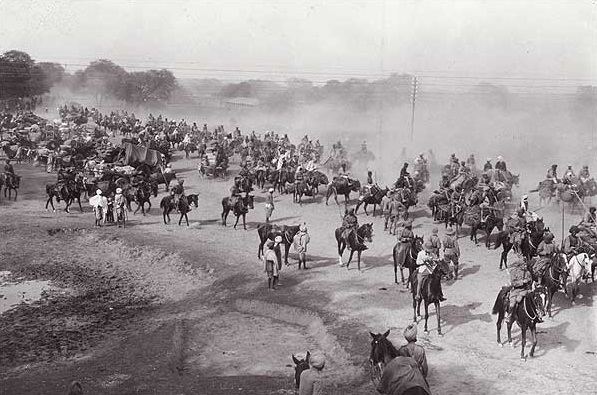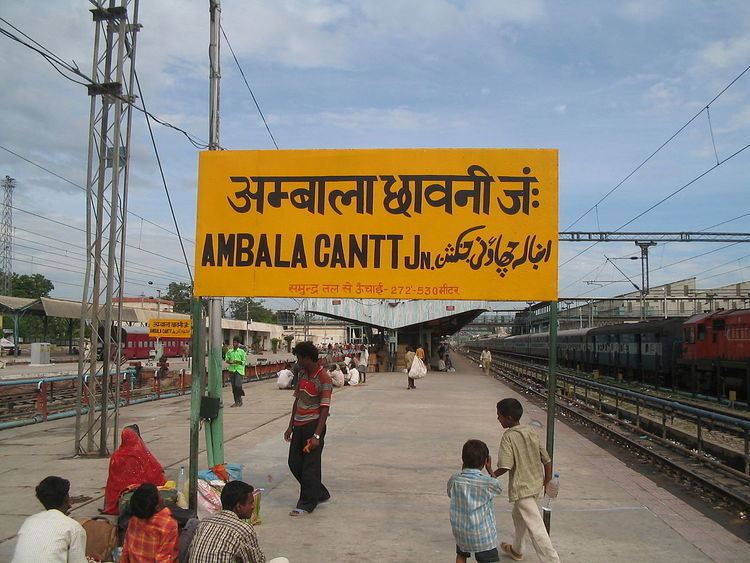Country India Area 1,568.85 km2 District Ambala | Languages spoken Hindi, Punjabi State Founded By Amba Rajput | |
 | ||
Map of Ambala
Ambala is a city and a municipal corporation in Ambala district in the state of Haryana, India, located on the border with the Indian state of Punjab and in proximity to both states capital Chandigarh. Politically; Ambala has two sub-areas: Ambala Cantonment also known as (Ambala Cantt) and Ambala City, approximately 3 kilometers apart, therefore it is also known as "Twin City". It has a large Indian Army and Indian Air Force presence within its cantonment area. Ambala separates the Ganges river network from the Indus river network and is surrounded by two rivers – Ghaggar and Tangri – to the north and to the south. Due to its geographical location, the Ambala district plays an important role in local tourism, being located 47 km (28 miles) south of Chandigarh, the state capital, 148 km (93 miles) southwest of Shimla, 198 km (121 miles) north of New Delhi and 260 km (155 miles) southeast of Amritsar.Gurudwara Manji Sahib is situated in Ambala.
Contents
- Map of Ambala
- Tourism driving directions from ambala to manali
- Ambala cantt market dashcam pov ambala babyal india
- History
- The Ambala Cantonment
- European Cemetery
- Formation of Ambala district
- Ambala Air Force Base
- Hanging of Mahatma Gandhis assassin Nathuram Godse
- Demographics
- Cloth Market
- Science market
- Education
- Transport
- Roadways
- Railways
- Notable residents
- References

Tourism driving directions from ambala to manali
Ambala cantt market dashcam pov ambala babyal india
History
It is said that Ambala District was founded by Amba Rajput during the 14th century CE. Another version is that the name is a corruption of Amba Wala meaning the mango-village, from mango groves which existed in its immediate neighborhood. Still, another version is that the District has taken its name after goddess "Bhawani Amba" whose Temple still exists in Ambala city..In 1709, Battle of Ambala was fought and Sikhs captured Ambala from mughals.
The Ambala Cantonment
Ambala Cantonment was established in 1843 after the British were forced to leave its Karnal Cantonment following the malaria epidemic of 1841–42 in as there were not any known effective means to control malaria epidemic in those days. The cantonment houses the '2 Corps', one of the three Strike Corps of the Indian Army.
European Cemetery
Ambala Cantonment is location of historic Ambala European Cemetery.
Formation of Ambala district
Ambala was given the status of a district in 1847, formed by the merging of the jagir estates of hitherto independent chieftains whose territories had lapsed or had been confiscated by the British Indian Government. In its 160 years of existence as a district, Ambala has witnessed many changes in its boundaries. Previously, it extended across tehsils of Ambala, Saphera, Jagadhri, Pipli, Kharar, Ropar and Nalagarh. Kalka-cum-Kurari State, Pinjore, Mani Majra, Kasauli & Sanawar were also merged later into the district at different times.
Ambala Air Force Base
Ambala Air Force Base is one of the oldest and largest airbases that were inherited from the British by the IAF. It was from this airbase that Spitfires and Harvards flown by Instructors of the Advanced Flying Training School took part in the 1947-48 Kashmir Operations. Subsequently, Ambala was the front line airfield for many years. It was home to various aircraft that were inducted into the Indian Air Force. Vampires, Ouragans, Hunters, etc. all flew from this base. The airbase was briefly attacked in 1965 by B-57 bombers of the Pakistan Air Force. Today, the Airbase houses the '7 Wing' with squadrons of Jaguars and MiG-21 Bisons. A unit of the French-made Dassault Rafale will also be based at Ambala air base.
Hanging of Mahatma Gandhi's assassin Nathuram Godse
In November 1949 Mahatma Gandhi's assassin, Nathuram Godse was hanged at Ambala Central Jail along with Narayan Apte, a co-conspirator. Ambala Cantt is also mentioned in Kim (novel) by Rudyard Kipling.
Demographics
As of 2011 India census, Ambala UA had a population of 207,934 consisting of 112,840 males and 95,094 females, a ratio of 843. there were 20,687 children 0-6 and Ambala had an average literacy rate of 89.31%, with 91.76% of males and 86.41% of females literate.
Cloth Market
"Cloth Market" is the charm of the city, which draws shoppers from surrounding areas. The cloth market has a dense cluster of 900-1000 wholesale shops.
The market possesses a wide range of cloth items:
The areas surrounding the market thrive on this market for occupation. Market provides all kinds of cloth tailoring related and other transportation occupations to semi-urban areas around. This market remains closed on Thursday, Holi, Republic Day, Independence Day and Dussehra are the only other days the market remains closed.
Himachal Pradesh and Punjab are major parts from which shopkeepers come to this market. Silk and Sarees are one of the major type of cloth sold by volume. Ambala used to be a hub of hand-loom factories, man operated industry, which has almost vanished.
This market is regarded as the largest cloth trading market in the sub-continent (Asia).
Science market
Ambala is known as city of scientific instruments. It is a major scientific products market and is a hub for products like glass apparatus, microscopes, laboratory equipment etc. Ambala contributes nearly 34% of the total production of scientific instruments produced in India.
Education
Ambala has a large number of schools and colleges. Notable colleges include:-
Transport
Ambala is connected to all of the other major cities of north India including Delhi, Chandigarh, Amritsar and Shimla. It is a big interchange for various commuters for all neighbouring states. The Ambala Cantt bus stand witnesses roughly 50,000 commuters daily.
National highway NH 1 popularly known as GT road passes through Ambala and connects it to National capital Delhi, Panipat, Ludhiana and Amritsar. NH 22 connects it to state capital Chandigarh and Shimla. National Highway 52 connects it to Kaithal, Narwana and Hisar. Apart from the Interstate service, Ambala also houses one of the oldest local bus service in Haryana, which is run by both Haryana roadways and private companies. Other means of local transportation include auto rickshaws and cycle rickshaws.
Roadways
Bus service is the major means of public Transport in this district. Ambala depot came into being on 1.8.1950. The office of the General Manager is situated in the premises the depot workshop at Ambala City. Ambala depot has a sub depot at Naraingarh.
Presently, Haryana Roadways, Ambala has 209 buses, which carry about 34.88 Lacs passengers daily and cover a distance of about 19.79 Lacs Km daily. Out of these, total distance covered on interstate routes is 24,711 km and 41,439 km are operated within Haryana every day. The total staff of the depot (including that of sub depot Naraingarh) is 1085.
New Bus Stand at Ambala Cantt was inaugurated on 12.7.1999 and the total land of bus stand is 6.7 acre. Bus stands in this district exist at Ambala City, Naraingarh and Barara as well. A sub depot level workshop has also been provided at Naraingarh. 'Yatri Niwas' exists in the campus of Ambala Cantt. bus stand for the convenience of the commuters who wish to stay for the night.
Besides, the Haryana Roadways buses, government has issued permits to private operators on local routes. Presently 51 such buses are plying in Ambala district. Bus stand is very near to Ambala Cantt Jn. (Railway station). Most of the buses plying on GT road (NH1) stop in front of Railway station.
Railways
Ambala is a divisional headquarters of the Northern Railway Zone and is an important railway junction. Ambala Cantt station is among top 100 booking stations of India. The city is served by three railway stations:
The Ambala Cantonment railway station was founded on the junction of the Delhi-Kalka and Ludhiana-Saharanpur lines. The historic Delhi-Panipat-Ambala-Kalka railway line dates back to 1889 while the Ludhiana-Saharanpur line was built in 1870. Situated 200 km north of Delhi, this town is well connected by the rail and road network.
Ambala cantt railway station is main station of the city and is well connected with major cities of India like Delhi, Jammu, Chandigarh, Amritsar, Panipat, Lucknow, Kanpur Howrah, Patna, Mumbai, Jaipur, Ajmer, Surat, Chennai, Pune and many more. Kalka-Shimla Railway which is UNESCO's World Heritage site also comes under Ambala division.
Ambala Cantonment Railway Station serves maximum Shatabdi Express after New Delhi. Ambala railway station was mentioned in the famous story 'The Woman on Platform 8' by Ruskin Bond, although in reality, there in no platform no 8 in Ambala Cantt.
